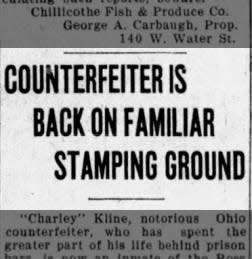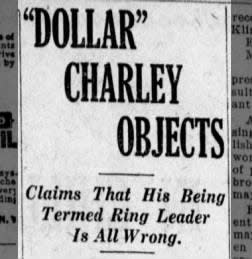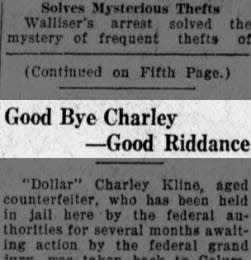Looking Back: A jailbreak in 1923 is foiled by a prepared sheriff
It was pitch black and deathly still inside the holding cell at the Ross County jail when shortly before 2 a.m. Oct. 9, 1923, “Dollar” Charley Kline, Denver Hatfield and Joseph Schiel quietly rose from their cots. A dozen prisoners were sound asleep, or at least pretended to be. They had been threatened with death if they dared open their mouths.

The trio tiptoed to a corner of the cell where Kline, a veteran counterfeiter and the supposed ringleader of the group, knelt one knee on the ground and gently tugged on one of the lower cell bars. It broke loose very easily, being held together with only beeswax. A second bar came loose just as easily, creating a small opening.Without saying a word, Kline squeezed through the tiny escape hatch and into the corridor and was quickly followed by the other two men. After Schiel, the most violent of the three, crawled through the hole, he stood and in well-rehearsed movements pulled a rag from his pocket and walked to a peephole where prisoners could be observed by authorities and stuffed it with the cloth.
The men then made their way to a stove in the corner of the hallway where they retrieved tools hidden under the grating - a hacksaw, extra blades, a drill, file and jar of Vaseline. With escape tools in hand, the men moved to a barred window, where freedom awaited them on the other side.
One of the inmates slathered a glob of the Vaseline on the cast iron bars, which dulled the noise of the hacksaw blade scraping back and forth. Pumped full of adrenaline, they worked quickly and efficiently, having had much practice sawing through the bars of the holding cell. Hatfield, the youngest of the three inmates, likely did most of the grunt work.

Unbeknownst to the three would-be escapees, however, while they were busy sawing away, a broom handle poked through the peephole and the cloth rag silently dropped to the ground. From his front row seat, Sheriff Don Swepston watched the men frantically pushing and pulling the blade.
The three prisoners were equally unaware that outside, underneath the very window they were attempting to escape from, a Ross County deputy waited with a gun and orders to “crack” the first head that appeared through the window. The men thought they were 15 or 20 minutes away from freedom, but one of their fellow prisoners, despite the threats, had ratted them out. They never stood a chance.
About 100 years ago, a cleverly attempted escape by three inmates being held inside the Ross County jail was front page news. The men had planned and rehearsed their escape for three weeks but in a way the story of the plot stretched back nearly a decade earlier.
In 1915, Kline had been incarcerated in the same Ross County jail and had helped foil an escape attempt by seven “safe blowers,” who were being held on federal charges. Swepston was the jailer at the time and his father, Alonzo Swepston, was sheriff. The jailbreakers had contemplated murdering one or both of them and Kline’s tip may have saved their lives. The Swepston family never forgot.
Therefore, after the 67-year-old Kline, who had spent over half of his life in one penitentiary or another, landed back in the Ross County jail, he was warmly welcomed. He greeted the sheriff’s wife with “Hello, mother,” and she made a special effort to make his stay as comfortable as possible. Kline’s elderly wife, for example, begged to sit near her husband and have meals with him and she had a rocking chair placed just outside his cell.
The steel-gray-haired Kline was a notorious Ohio counterfeiter and not your ordinary criminal. Despite a lifetime behind bars, he had a cultured look about him and his speech was that of a well-educated man. He learned to be a machinist in the penitentiary but only used his skills in the “craft” of counterfeiting. It was his love, his passion, his life. He compared himself to an artist who gave his soul to painting, despite the fact that his “art” consistently placed him behind bars.
“It is not the idea of making money that keeps me at it,” he insisted. “It is the love of creating a perfect piece of work.” He was especially proud that since the discontinuation of the silver dollar, he started making fifty-cent pieces. “Their ring and appearance are identical to the real thing and few people can tell the difference in weight by picking up the coin,” he boasted.

Despite his pretentions, though, Kline was a career criminal and used Sheriff Swepston, his deputies and family’s kindness to plot his escape. At the same time his wife rocked in her chair and shared special meals with her husband, for instance, she passed him the escape tools.
Next, Kline recruited Schiel, who was in jail for the attempted murder of a railroad detective, and Hatfield, locked up for stealing cars. The three men rehearsed the jailbreak plan until they were blue in the face. They were speechless after Sheriff Swepston and his deputies interrupted their sawing at the window, but they yielded.
It was quickly learned that Kline was the mastermind behind the plot, despite his protestations to the contrary. The Gazette even published a letter from him airing his grievances.
If reporters investigated the facts of the attempted escape, he contended, “it will be found that it was as deep as it was broad and sensational in the extreme.” He was especially incensed that his wife was accused of sneaking tools to him. “She would not bring a wooden toothpick into the jail,” he wrote.

Ross County jail officials, however, were no longer taken in by Kline’s charm and charisma. After he was transferred to a jail in Columbus, the Gazette summed up the feelings of the sheriff and his family. “Goodbye Charley! Good riddance!”
This article originally appeared on Lancaster Eagle-Gazette: Looking back: A 1923 escape attempt at the Ross County Jail

